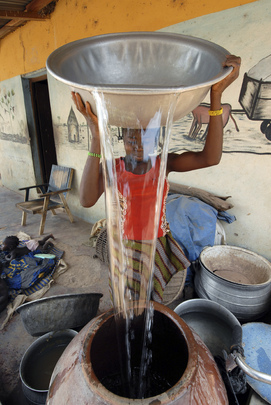December 2022 - You are accessing an archived version of our website. This website is no longer maintained or updated. The Sustainable Development Knowledge Platform has been migrated here: https://sdgs.un.org/
December 2022 - You are accessing an archived version of our website. This website is no longer maintained or updated. The Sustainable Development Knowledge Platform has been migrated here: https://sdgs.un.org/
 With only a short time before the end of 2015 - the MDGs- target year - water and sanitation challenges are still daunting. The Secretary-General-s Advisory Board on Water and Sanitation (UNSGAB) is committed to continue its advocacy efforts through 2015. To that end, the Board has formulated a set of activities as part of Hashimoto Action Plan III (HAP III). Both HAP I and II, named to commemorate UNSGAB-s first Chair Ryutaro Hashimoto, helped set a framework for global action on water and sanitation challenges. In this spirit, HAP III will make a final push for the sanitation and water Millennium Development Goal targets as well as advocating for strong water and sanitation objectives in the post 2015 development framework. To underpin these efforts activities on financing, wastewater management, pollution prevention, integrated water resources management, the water-food-energy nexus and water and disasters are included.
Just like HAP I and HAP II, an important mandate of HAP III continues to be delivering access to safe drinking water and adequate sanitation - it is time now to aim for universal access to safe drinking water and adequate sanitation - along with the data collection and monitoring tools which demonstrate the need and usefulness of our goals and the progress we are making towards them.
UNSGAB recognizes that water challenges cover a wide spectrum. Making progress on access to safe drinking water and sanitation is impossible without due attention to the larger water cycle underpinned by an ambitious global water vision.
For example, safe drinking water cannot be guaranteed if wastewater management and pollution prevention is not well promoted and implemented; water efficiency and water resource management are becoming critical considerations to provide safe drinking water. Without sustainable financing structures that draw more heavily on national, local and pooled funding sources, progress will be piecemeal. Therefore UNSGAB commits to address these challenges as well under HAP III.
In addition, the reduction of disaster risk remains a priority in HAP III. Water-related disasters can wash away in seconds several decades worth of progress; their impact can be significantly decreased with robust disaster preparedness.
With only a short time before the end of 2015 - the MDGs- target year - water and sanitation challenges are still daunting. The Secretary-General-s Advisory Board on Water and Sanitation (UNSGAB) is committed to continue its advocacy efforts through 2015. To that end, the Board has formulated a set of activities as part of Hashimoto Action Plan III (HAP III). Both HAP I and II, named to commemorate UNSGAB-s first Chair Ryutaro Hashimoto, helped set a framework for global action on water and sanitation challenges. In this spirit, HAP III will make a final push for the sanitation and water Millennium Development Goal targets as well as advocating for strong water and sanitation objectives in the post 2015 development framework. To underpin these efforts activities on financing, wastewater management, pollution prevention, integrated water resources management, the water-food-energy nexus and water and disasters are included.
Just like HAP I and HAP II, an important mandate of HAP III continues to be delivering access to safe drinking water and adequate sanitation - it is time now to aim for universal access to safe drinking water and adequate sanitation - along with the data collection and monitoring tools which demonstrate the need and usefulness of our goals and the progress we are making towards them.
UNSGAB recognizes that water challenges cover a wide spectrum. Making progress on access to safe drinking water and sanitation is impossible without due attention to the larger water cycle underpinned by an ambitious global water vision.
For example, safe drinking water cannot be guaranteed if wastewater management and pollution prevention is not well promoted and implemented; water efficiency and water resource management are becoming critical considerations to provide safe drinking water. Without sustainable financing structures that draw more heavily on national, local and pooled funding sources, progress will be piecemeal. Therefore UNSGAB commits to address these challenges as well under HAP III.
In addition, the reduction of disaster risk remains a priority in HAP III. Water-related disasters can wash away in seconds several decades worth of progress; their impact can be significantly decreased with robust disaster preparedness.